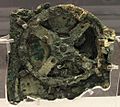Orrery facts for kids
An orrery is a special kind of mechanical model. It shows how the planets in our Solar System move around the Sun. It also shows the positions of the moons. Most orreries are heliocentric, which means they show the Sun at the center, with the planets orbiting it.
What is an Orrery?
Orreries are like miniature versions of our Solar System. They help us understand how planets and moons move. They are usually powered by a clockwork mechanism, similar to the inside of a clock. The Sun is usually a globe in the middle, and each planet is on an arm, moving around it.
A Look Back: The History of Orreries
People have been interested in showing how the sky works for a very long time. The ancient Greeks had early versions of these models, sometimes called planetaria.
The first known device that worked like a modern orrery was the Antikythera mechanism. This amazing ancient Greek machine was built around 60 to 150 years before BC. It was a complex device that could predict astronomical events.
The first modern orrery was made in 1704. One of these early models was given to a nobleman named Charles Boyle, 4th Earl of Orrery. That's how these cool models got their name!
Images for kids
-
Antikythera mechanism (main fragment), ca. 125 BCE
-
Carlo G Croce, reconstruction of Dondi's Astrarium, originally built between 1348 and 1364 in Padua
-
A Philosopher Lecturing on the Orrery (ca. 1766) by Joseph Wright of Derby
-
The orrery built by wool carder Eise Eisinga from 1774 to 1781 in his living room, the oldest functioning planetarium in the world
-
An orrery made by Robert Brettell Bate, circa 1812. Now in Thinktank, Birmingham Science Museum.
See also
 In Spanish: Planetario mecánico para niños
In Spanish: Planetario mecánico para niños










